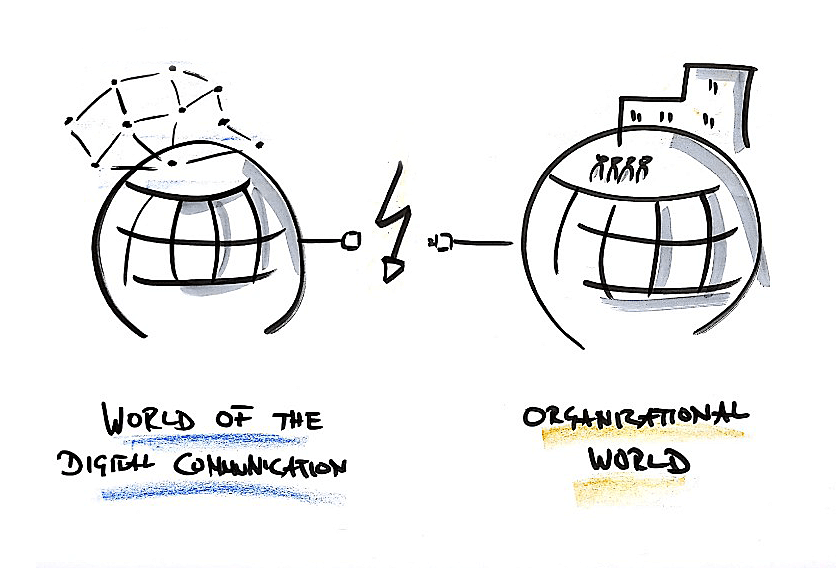“Ok people, we’re now moving right into our digital future! We shift our media spending and budget to online marketing communications to reach our target markets better to prepare for the future — Let’s rock it all together!”

This phrase could be presented at any companies 2017th Christmas party, and whoever is proposing it might be looking into employees faces which show an emotional mixture of “ok — finally…” and “aha, and what does this actually change and what’s in it for me??”.
At first, the change is usually perceptible only outside the organization: The website is (re-)launched, digital marketing agencies present concepts of “how to make your company great in the world wide web”, social media activities and “influencer strategies” are derived and the shift to digital marketing communication begins.

However, implementing a digital communication mix to an existing organizational process has high impact and could change the daily workflow, the interpersonal relations and to be honest, especially the relationship with the customers.
It impacts the established status of the whole organization!
The perception vs. reality gap

There is a gap to fill: The new digital communication activities create new expectations! Stakeholder groups such as potential employees, customers or investors perceive the company as “digitally developed” because of their constructed image in the digital world through:
- Social Media Activities
- Websites, Microsites, Google-Campaigns
- Digital Lead Generation approaches
- Instant digital feedback tools etc.
It is now crucial to also live the digital communication approach inside the organization. Otherwise, frustration could build within the target groups, such as the following examples:
Michael, a 27-year-old university graduate is highly interested in a job the “XYZ-Company” is currently offering. They have a great junior development concept, presented on an appealing and user-friendly website with lots of testimonials and videos showing “XYZ” as a great place to work for Millennials like Mike. On Social Media Platforms they share stories of their daily work, full of enthusiastic people trying to be great at everything inside their jobs they love so much.
Michael also likes to communicate online, is using instant messaging in several situations in his daily life and loves the “digital transformation” which takes place in our industries nowadays.
After a successful interview “XYZ” finally offers Mike the job he wanted. Happy and full of hope and expectations he comes to his first day in the office.
Within days he finds out that in fact, the company is not in any way living a digital culture.
- The intranet is used just for the daily cafeteria-menu
- The CRM-Software is in the phase of “Roll-Out” since 2016
- Video-Content, Website, Social Media Content and all the testimonials are created and driven by an external marketing agency
- And the worst: His boss (born in the baby-boom-generation) hates Apps, smartphones, new software technologies and only communicates via horribly written emails.
The result is, disappointment and for the company avoidable recruiting costs…
Another example leads us to unhappy customers. Top-designed websites and well-conceived sales funnels invite potential new customers to interact via digital communication tools (Email, instant messaging, Social Media etc.) with your company. Unfortunately, the employees receiving the messages communicate like five years ago:
- Emails get answered after three or more days, even in urgent cases
- They use capital letters to EMPHASIZE THEIR MESSAGE (and make people feel intimidated because they shout at them 🙂 )
- They aren’t able to send files in proper data formats, forget appendices and in fact have no clue how to communicate in the digital world
- They have no awareness of content, special offerings and value propositions their own company is communicating via digital marketing channels
We all know many more stories of extremely frustrating sales communications.
However, in fact, it is not their fault! It is the fault of any manager who is not aware of the situation that there is an increasing gap between the digital image of the organization and the actual communication behavior of all the people inside the company.
Even if you have a brilliant digital sales funnel, inside the organization, there still is the same staff, the same attitudes, the same habits, fears and the same people from before the “digital change”.
Overall, this is not a problem. It is a challenging chance to develop the organization further.
Creating a digital culture
To close this gap between the digital and the organizational world a digital change management process should be started at the same time the company launches their digital campaigns.

The following four steps are my proposal how to start your digital organizational culture:
1. Inform and create Acceptance & Understanding
Inform the people in your organization, what you’re doing in the digital world and what kind of changes they will experience. Let them “feel” what it means to “think, act and communicate” digital. This information reduces resistance and helps people move forward from their old behavior and dogmas.
2. Mobilize
Generate a movement and inspire people to pull together in the digital communication projects. Be a role model!
3.Enable
Train and implement the new spirit in the daily workflow. Measure the impact and show achieved success!
4. Lived Performance
Let the achievements, new spirit and newly learned structures became a daily routine!
Of course, it is a tough path to walk but also a big chance to prepare the organization for the digital change and a first step to a truly lived digital culture!




